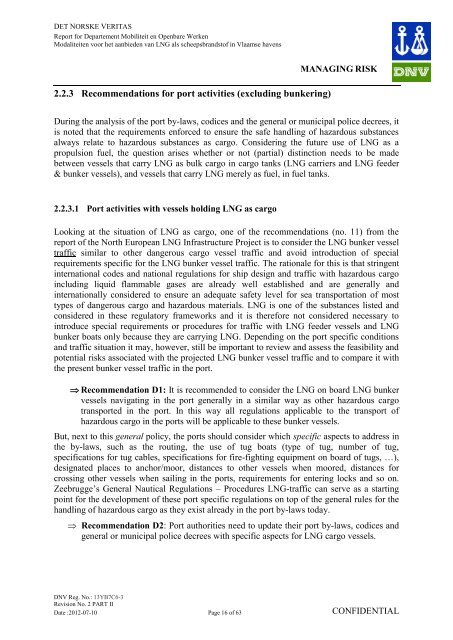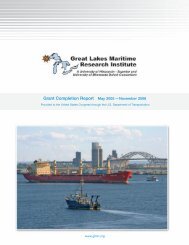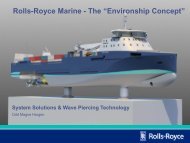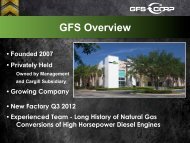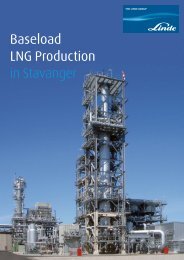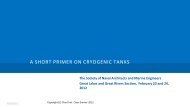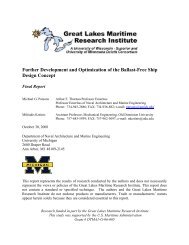Modalities for the provisioning of LNG as shipping fuel in Flemish Ports
Modalities for the provisioning of LNG as shipping fuel in Flemish Ports
Modalities for the provisioning of LNG as shipping fuel in Flemish Ports
Create successful ePaper yourself
Turn your PDF publications into a flip-book with our unique Google optimized e-Paper software.
DET NORSKE VERITAS<br />
Report <strong>for</strong> Departement Mobiliteit en Openbare Werken<br />
Modaliteiten voor het aanbieden van <strong>LNG</strong> als scheepsbrandst<strong>of</strong> <strong>in</strong> Vlaamse havens<br />
2.2.3 Recommendations <strong>for</strong> port activities (exclud<strong>in</strong>g bunker<strong>in</strong>g)<br />
MANAGING RISK<br />
Dur<strong>in</strong>g <strong>the</strong> analysis <strong>of</strong> <strong>the</strong> port by-laws, codices and <strong>the</strong> general or municipal police decrees, it<br />
is noted that <strong>the</strong> requirements en<strong>for</strong>ced to ensure <strong>the</strong> safe handl<strong>in</strong>g <strong>of</strong> hazardous substances<br />
always relate to hazardous substances <strong>as</strong> cargo. Consider<strong>in</strong>g <strong>the</strong> future use <strong>of</strong> <strong>LNG</strong> <strong>as</strong> a<br />
propulsion <strong>fuel</strong>, <strong>the</strong> question arises whe<strong>the</strong>r or not (partial) dist<strong>in</strong>ction needs to be made<br />
between vessels that carry <strong>LNG</strong> <strong>as</strong> bulk cargo <strong>in</strong> cargo tanks (<strong>LNG</strong> carriers and <strong>LNG</strong> feeder<br />
& bunker vessels), and vessels that carry <strong>LNG</strong> merely <strong>as</strong> <strong>fuel</strong>, <strong>in</strong> <strong>fuel</strong> tanks.<br />
2.2.3.1 Port activities with vessels hold<strong>in</strong>g <strong>LNG</strong> <strong>as</strong> cargo<br />
Look<strong>in</strong>g at <strong>the</strong> situation <strong>of</strong> <strong>LNG</strong> <strong>as</strong> cargo, one <strong>of</strong> <strong>the</strong> recommendations (no. 11) from <strong>the</strong><br />
report <strong>of</strong> <strong>the</strong> North European <strong>LNG</strong> Infr<strong>as</strong>tructure Project is to consider <strong>the</strong> <strong>LNG</strong> bunker vessel<br />
traffic similar to o<strong>the</strong>r dangerous cargo vessel traffic and avoid <strong>in</strong>troduction <strong>of</strong> special<br />
requirements specific <strong>for</strong> <strong>the</strong> <strong>LNG</strong> bunker vessel traffic. The rationale <strong>for</strong> this is that str<strong>in</strong>gent<br />
<strong>in</strong>ternational codes and national regulations <strong>for</strong> ship design and traffic with hazardous cargo<br />
<strong>in</strong>clud<strong>in</strong>g liquid flammable g<strong>as</strong>es are already well established and are generally and<br />
<strong>in</strong>ternationally considered to ensure an adequate safety level <strong>for</strong> sea transportation <strong>of</strong> most<br />
types <strong>of</strong> dangerous cargo and hazardous materials. <strong>LNG</strong> is one <strong>of</strong> <strong>the</strong> substances listed and<br />
considered <strong>in</strong> <strong>the</strong>se regulatory frameworks and it is <strong>the</strong>re<strong>for</strong>e not considered necessary to<br />
<strong>in</strong>troduce special requirements or procedures <strong>for</strong> traffic with <strong>LNG</strong> feeder vessels and <strong>LNG</strong><br />
bunker boats only because <strong>the</strong>y are carry<strong>in</strong>g <strong>LNG</strong>. Depend<strong>in</strong>g on <strong>the</strong> port specific conditions<br />
and traffic situation it may, however, still be important to review and <strong>as</strong>sess <strong>the</strong> fe<strong>as</strong>ibility and<br />
potential risks <strong>as</strong>sociated with <strong>the</strong> projected <strong>LNG</strong> bunker vessel traffic and to compare it with<br />
<strong>the</strong> present bunker vessel traffic <strong>in</strong> <strong>the</strong> port.<br />
Recommendation D1: It is recommended to consider <strong>the</strong> <strong>LNG</strong> on board <strong>LNG</strong> bunker<br />
vessels navigat<strong>in</strong>g <strong>in</strong> <strong>the</strong> port generally <strong>in</strong> a similar way <strong>as</strong> o<strong>the</strong>r hazardous cargo<br />
transported <strong>in</strong> <strong>the</strong> port. In this way all regulations applicable to <strong>the</strong> transport <strong>of</strong><br />
hazardous cargo <strong>in</strong> <strong>the</strong> ports will be applicable to <strong>the</strong>se bunker vessels.<br />
But, next to this general policy, <strong>the</strong> ports should consider which specific <strong>as</strong>pects to address <strong>in</strong><br />
<strong>the</strong> by-laws, such <strong>as</strong> <strong>the</strong> rout<strong>in</strong>g, <strong>the</strong> use <strong>of</strong> tug boats (type <strong>of</strong> tug, number <strong>of</strong> tug,<br />
specifications <strong>for</strong> tug cables, specifications <strong>for</strong> fire-fight<strong>in</strong>g equipment on board <strong>of</strong> tugs, …),<br />
designated places to anchor/moor, distances to o<strong>the</strong>r vessels when moored, distances <strong>for</strong><br />
cross<strong>in</strong>g o<strong>the</strong>r vessels when sail<strong>in</strong>g <strong>in</strong> <strong>the</strong> ports, requirements <strong>for</strong> enter<strong>in</strong>g locks and so on.<br />
Zeebrugge’s General Nautical Regulations – Procedures <strong>LNG</strong>-traffic can serve <strong>as</strong> a start<strong>in</strong>g<br />
po<strong>in</strong>t <strong>for</strong> <strong>the</strong> development <strong>of</strong> <strong>the</strong>se port specific regulations on top <strong>of</strong> <strong>the</strong> general rules <strong>for</strong> <strong>the</strong><br />
handl<strong>in</strong>g <strong>of</strong> hazardous cargo <strong>as</strong> <strong>the</strong>y exist already <strong>in</strong> <strong>the</strong> port by-laws today.<br />
Recommendation D2: Port authorities need to update <strong>the</strong>ir port by-laws, codices and<br />
general or municipal police decrees with specific <strong>as</strong>pects <strong>for</strong> <strong>LNG</strong> cargo vessels.<br />
DNV Reg. No.: 13YB7C6-3<br />
Revision No. 2 PART II<br />
Date :2012-07-10 Page 16 <strong>of</strong> 63 CONFIDENTIAL


